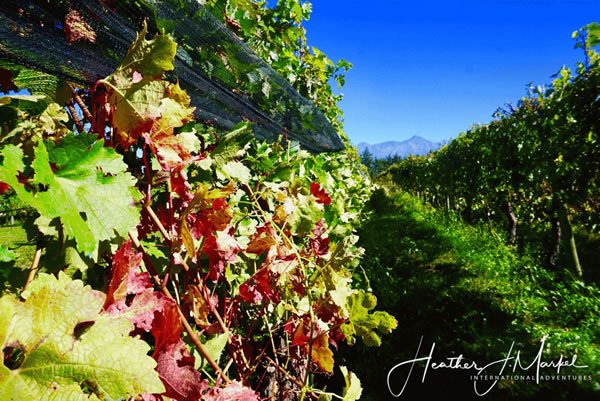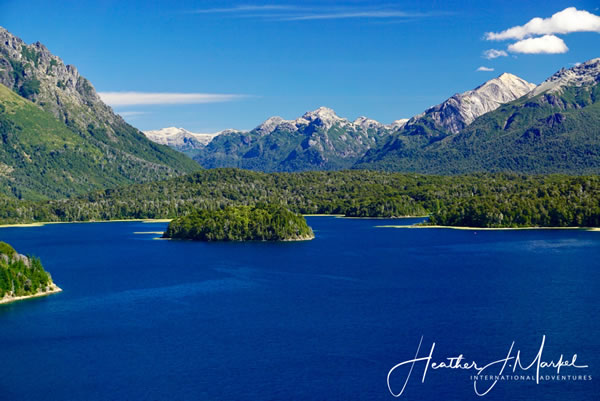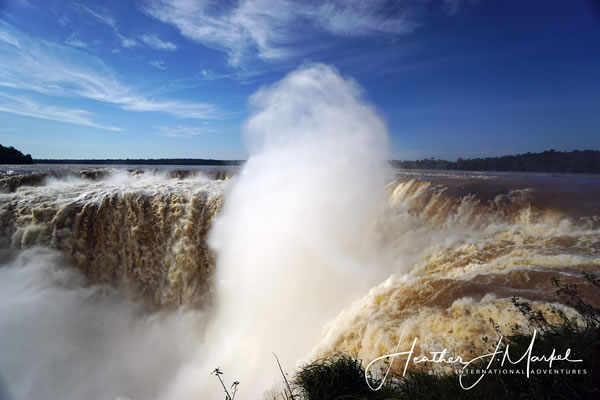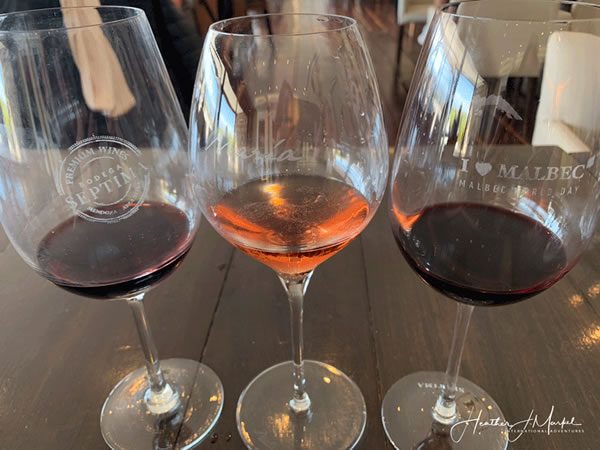A Guide to Culture and Life in Argentina
When Long-Term Travel is Short-Term Living Abroad
Article and photos by Heather Markel
Published 11/14/2019

|
|
Penguins on Isla Martillo, Argentina.
|
If you’ve never been to Argentina, you probably associate it with excellent steak and tango dancing. If you’re going to live there, however, you’ll benefit from a deeper understanding of daily life and culture. So what is it about Argentina that makes it such a fascinating place for long-term exploration?
I went to Argentina intending to spend a couple of months in order to see a few major cities. Instead, I found myself loving places so much I extended my time in many cities and couldn’t seem to feel any desire or find any reason to leave. Strangely, most of the cities are not overly interesting by themselves; it’s nature and sites nearby that you’ll want to see. And the people of Argentina will make you want to stay.
History of Argentina
The indigenous people of Argentina were mainly Mapuche, though there were several other tribes such as Guarani and Kolla. They were almost entirely wiped out by colonization — some killed with weapons, but many more perished due to new diseases brought over by settlers from the "Old World." You can see traces of indigenous peoples and learn more about them in locations like Ushuaia.
Argentina’s history consists of wave after wave of immigrants from Spain, Italy, and Germany, among others, so many Argentinians you meet will be of mixed ancestry. The varied backgrounds play a role in the foods enjoyed (among other dishes you’ll find lots of pizza and pasta!), the wines, and the languages.
There’s some bad blood due to the history related to the Falkland Islands. You won’t find the area spoken about too much, but you will learn that it’s impossible to fly directly from anywhere in Argentina to the Falklands. You must fly via Chile. Argentina still harbors resentment that Britain rebuffs its claim to the territory.
There’s also a good deal of competitive spirit between Argentina and Chile. As an interesting example, the city of Ushuaia is considered the world’s southernmost city, dubbed “the city at the end of the world.” However, there’s a town in Chile with roughly 5,000 inhabitants that’s further south. Because it’s a town, not a city, Ushuaia maintains its slogan. So, Chile is in progress of creating a law that allows towns with 5,000 inhabitants to be called a city!
Landscape in Argentina
Argentina is 1,073,518 square miles or 2,780,400 Kilometers. It’s big! There are so many varieties of nature, wildlife, and geology that when you visit long-term, you’ll feel as though you are actually inside several different countries.
The south, known as Patagonia, presents some of the most beautiful terrain in Argentina, complete with lakes, mountains, hiking, and penguins. The north features surprisingly high altitudes, multi-colored rock formations, salt flats, and waterfalls. In the land between you’ll find wine, empanadas, tango, cows, and guanaco.

|
|
Mendoza vineyard.
|

|

|
|
Bariloche.
|

|
|
Iguazu Falls.
|
Regions and Cities
You will soon realize that Argentina is divided into regions such as Neuquén, Mendoza, and Salta. Each of those regions has a city with the same name! So, you may find yourself in Mendoza, Mendoza or Neuquén, Neuquén. When someone tells you where they’re from, it could be the region or the city that they mean. If someone advises you to visit Neuquén, for example, you need to clarify whether they mean the city or the region. If you’re taking a bus for a vacation in Mendoza, make sure you request the schedule to the city of Mendoza.
People and Language
of Argentina
Argentineans are generally warm and friendly people. The informal Spanish “you” is widely used. Note that they speak Castellan, thanks to the Spanish immigrants that largely settled there in the 1500s. So, the word for "you" is “vos” instead of “tu.” The accent varies enormously from South to North; in the South, I am from “Nueva York,” but in the North I am from “Nueva Jork.” Buenos Aires has a dialect recognizable by the way they pronounce the letter “s.”
Language aside, I often found myself in beautiful conversations with local kiosk owners in many towns. They wanted to know in-depth about my life and reciprocated by telling me about theirs.
As a female solo traveler, I found that the Argentinian women I met on my journeys all felt a desire to take care of me. They’d make sure I got home safely, that I was happy, and thoughtfully treated. But it wasn’t just the women. One time I took a local bus to a nearby beach. A couple on the bus asked if I was alone, and when I said yes, insisted that I sit near them. It wasn’t about safety; it was about companionship. I frequently felt “taken in” by strangers and looked after such that I rarely felt alone.
If you’re going to spend a large amount of time in Argentina, do yourself a favor and be respectful by learning Spanish. There are many places where no one speaks English. You’ll have a much easier time if you speak the local lingo. I’d recommend learning Spanish in Argentina, because depending on the region you find yourself, the accent and words may vary enormously from the Spanish you may have learned back home.
Argentinian Wines

|
|
Mendoza wine tasting.
|
It’s virtually impossible not to know about Malbec, even if you don’t drink it. Argentina is the epicenter of this vintage. Interestingly the grape varietal comes from France. When the French tried to make wine from this grape in France it tasted so bad they called it “mal bec,” as in “bad smell.” However, when a small group of French emigrated to Argentina in the mid-1850s, they brought the grape with them. The results were far better when the grape was grown in the Mendoza region, which offers different soil, abundant sun, mountains, and clear air.
No matter where in the country you are, you’ll be treated to some of the best Malbec in the world. However, you should spend at least a weekend in Mendoza visiting the various vineyards (called “bodegas”) to get a true taste of Argentinian wine. Worth noting are Bodega Salentein (a vineyard complete with a grand piano where concerts are performed amid the casks of fermenting wine) and Trapiche, easily accessible from the center of Mendoza. You can use the Mendoza tram to see the vineyards in Lujan or take the busvinivinicla (wine bus), which offers trips to different regions on different days, including Uco, which has the highest rated Malbec wines in Argentina.
Sugar
In Argentina, breakfast is sugar, ham, and cheese. The staple breakfast of Argentina is pastry, bread or croissants coated in sugar. If there’s no sugar on it, it’s not breakfast. (I hope I’ve said the same thing enough times that you get the point!)
If you prefer to avoid sugar, you can get ham, cheese slices, and eat them with some white bread. Honestly, I found these breakfasts very difficult to sustain during my four months in Argentina. There’s no variety, and the carbohydrate base left me feeling hungry by mid-morning. If you make your breakfast at home, you’ll find cereal easily enough, but most of the milk is “fake” — the kind that can sit in the carton for months, unused, which always makes me worry about chemicals. You can find eggs in the supermarket, but you’ll have a harder time finding an omelet or scrambled eggs for breakfast in you don't have access to a kitchen.
Meat, Meat, and More Great Meat
Argentina does have the best steak in the world! I’ve now been around the much of the globe and feel qualified to make such an assertion. It was so very good that I shifted from eating meat once a month to several times a week, and sometimes daily. Unfortunately, much of the population suffers from high blood pressure because of all the meat in their diet. Even though salt isn’t good for the condition, it’s more readily available than pepper, which you’ll have to ask for because it’s never on a restaurant table.
Get used to eating asado (meat grills), which can include beef, sausage, pork, chicken, and innards. For a real treat, go to a Tenedor Libre, which is a buffet barbeque minus the barbeque sauce. You go up to the grill area and ask for any meats you want to eat, and you must finish all the food on your plate before getting more — all for about $6. The cooking and spices are so perfect you won’t need any sauce. The one time I ordered a chorizo steak with a red wine sauce at a restaurant it ruined the authentic flavor of the meat.
Money in Argentina
Almost like a game of Monopoly where you must pick up a “chance” card daily, there’s a chance that the prices you paid for meat, milk, and ATM fees yesterday will be higher, or lower, today. Withdrawing money at the ATM is an adventure. Argentinian banks restrict you to a per-withdrawal amount of about $100, irrespective of your daily allowed withdrawal limit. You’ll pay roughly $5 - $10 for each transaction. Some foreign banks allow you to withdraw 7,500 pesos for each transaction (somewhere between $160 - $190, depending on the day), but you’ll pay about $12 per transaction. Keep in mind that these are only the Argentina bank transaction fees, which do not include fees your home bank charges.
Due to the high inflation in Argentina (over 120% in 2023!), most people prefer to be paid in cash and not via credit cards. Where credit cards are accepted, Visa and Mastercard are preferred over American Express. So, you’ll need cash, and you’ll have to pay extra for it. However, many places offer 10% discounts for payment in cash. Do the math and see whether your ATM fee is higher or lower than the pay-in-cash discounts. If you don’t see mention of a discount for cash, always ask.
SIM Cards
In January 2019, temporary SIM card rules changed, and it became more difficult for foreigners to get one. You can easily buy a card in any kiosk for around 50 Argentinian pesos. (Claro and Movistar are the biggest companies.) After completing your purchase, you have to find your chosen carrier’s Facebook page and send them the following information via instant messages:
-
A photo of you (a selfie on the spot is fine)
-
A photo of your passport
-
A photo of you holding your passport
-
The actual phone number you wish to use, or a photo of the plastic card with the number
-
How long you plan to be in Argentina.
Your carrier should send you a Facebook message within a day to let you know that the number is set up and help you with basic troubleshooting. Failing that, you may have to go into one of their offices. If you buy a recharge plan, you’ll have to top up every week or every month. You don’t get a ton of data at once, so weekly plans, I found, work better if you consume lots of data. I suggest that you only put that money on your SIM the actual day that your plan expires. If you try to recharge the number before that date, the money won’t be applied to extending your plan. Instead, the money will sit in a separate area and can only be applied to international calls, and expires after a few weeks. Top-ups can be done at local kiosks, though some of them will charge you a 5 - 15 peso fee. If you want to avoid that, either find a kiosk that doesn’t, or go to a Rapipago store.
Yerba Mate
To be part of authentic Argentinean culture, you must drink yerba mate. It seems simple — a cup, preferably made from wood or pumpkin gourd, a metal straw, a hearty portion of dried yerba plant leaves, and warm water. In reality, it’s a cup of connection. No matter where you go, you’ll see Argentinians carrying their yerba mate equipment either in a special carrying case or in their hands while they walk and sip it. Shop owners will be drinking a mate while you’re browsing. Taxi drivers may have a cup in hand when they pick you up. You’ll be invited to share mate with total strangers. Get over any germ fears you have and say yes. Sharing yerba mate is the most wonderful way to turn strangers into friends, and if you’re new to Argentina, you’ll surely want a few new friends! If you find you don’t like the taste, take the time to sample the many different kinds from the supermarket. Like tea, you can find strong and weak tasting varieties, fruit-flavored, and with or without stems. You’ll have to find your preference. Some people, I learned, find that the stronger blends are harder on the stomach, so if your belly is sensitive, stick to packages that have the word “suave” and you should be fine.
One of my favorite yerba mate experiences occurred as I took refuge from the extreme cold in a tiny town while a friend sought out accommodations for us all. I waited for my friend in the only shop on the street. The shop owner immediately invited me to share her mate. She introduced me to her young son. We spoke about her family, the town, and our lives. When my friend returned, her husband shared his as well and offered to drive us to our hostel! So sharing mate is truly a communal ritual, much more than just a drink. I don’t think you can say you’ve experienced Argentina if you don’t at least try a mate.
Visas
You’ll need to check the rules for your country, but Americans are allowed 90 days on a tourist visa, which is part of your passport stamp and doesn’t cost an additional fee. If you leave the country, even for a day trip to Chile, Paraguay, or Uruguay, for example, you get another 90 days when you return to Argentina. You can extend you stay endlessly this way, or until your money runs out.
Tango
You’ll hear more about tango in Buenos Aires than anywhere else in the country. You can watch tango, or you can dance tango. If you decide to watch it, there are many places offering dinner shows, even with pick-up and drop-off from your hotel. However, the price for a tango spectacle is reduced by almost 50% if you’re a local. If you don’t have a resident card, consider asking a local friend to buy the tickets for you.
If you prefer to dance tango, there are many schools around the city offering lessons. You can go solo, as a couple, or in a group. If you go solo, you’ll be partnered with other solos to learn the steps. Tango is deceptively difficult, so if you want to learn to dance well, plan to take at least a few lessons.
What’s amazing about Argentina isn’t just how big it is, but how many different experiences you can have. You can see and do almost everything in this country, including hiking, boat rides, walking with penguins, colorful mountains, salt flats, beautiful waterfalls, and a journey to the end of the world (Ushuaia). Make sure you take the time to see the many amazing sides of the country.
Weather and Altitude
Seasons are the reverse of the northern hemisphere. I found it strange to be freezing in 2% Celsius temperatures in the middle of July, normally accustomed to hot summers at that time of year. The further south you go in Argentina, the colder it becomes, another strange experience when, if you’re from the northern hemisphere, you’re used to traveling south for warmer weather.
Argentina also has micro-climates. While most of the country is cold or freezing in July, Iguazu remains warm or mild year-round. Pay attention to the altitude as well — it’s not just in Peru and Bolivia where you can experience altitude sickness. Areas near Salta offer beautiful views that come with a potential headache, even though it’s well worth it.
Getting Around Artentina
Argentina is such a huge country. Flying makes it easier to travel across the country and Aerolineas Argentinas is the main airline. Bus travel, if you have time, is cheaper and very safe. Your only challenge will be that every city has its own set of bus companies, so it’s impossible to understand every schedule and ticket price on one website. With that in mind, Busbud provides very helpful information for bus travel to most cities.
If you’re going to travel and live in Argentina, it’s well worth passing maximum time in each of its regions to understand the vast differences in people, culture, landscape, and language. Argentina is a fascinating country you should explore for as long as you possibly can.

|
Heather Markel left the corporate world 25 years into her career to pursue her passion of traveling the world and meeting people full time. Since January 2018, she has lived in 6 continents, over 20 countries and more than 100 cities. She shares her insights and travel knowledge at Heather Begins. Fueled by her experiences, she started a video series called The Inspired Nomads, where she interviews other mid-career professionals who have left their job to pursue their passion. She speaks 6 languages, is a former contributor to Entrepreneur.com, a serial entrepreneur and delights in discovering new varietals of red wine in her travels.
Note that all photos were taken by Heather Markel, are subject to Copyright and may not be re-used or published without express written consent from Heather.
|
|
